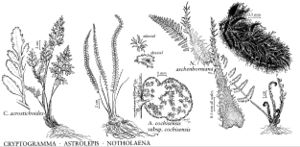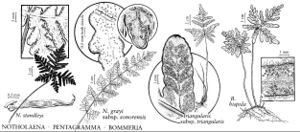Notholaena
Prodr. 145. 1810.
Plants usually on rock. Stems short-creeping to compact, ascending to horizontal, usually branched; scales black or often bicolored with dark central stripe and lighter margins, linear-subulate to lanceolate; margins ciliate, denticulate, or entire. Leaves monomorphic, clustered, 4–35 cm. Petiole brown or black, usually rounded, flattened, or with single longitudinal groove adaxially, often bearing scales, hairs, or farinose glands, with single vascular-bundle. Blade linear-lanceolate, ovate, deltate, or pentagonal, pinnate-pinnatifid to 4-pinnate, leathery, abaxially covered by yellowish or whitish farina (completely obscured by stellate scales in Notholaena aschenborniana), adaxially often sparsely glandular, dull, not striate; rachis straight. Ultimate segments of blade sessile to subsessile, often adnate to costae, narrowly elliptic to oblong-ovate or deltate, usually less than 4 mm wide; base rounded to truncate or cuneate; stalks (when present) usually lustrous and dark-colored; segment margins recurved to form confluent, poorly defined false indusia extending entire length of segment. Veins of ultimate segments free, obscure, pinnately branched and divergent distally. False indusia greenish, narrow, clearly marginal, occasionally concealing the sporangia. Sporangia confined to submarginal vein tips, containing 64, 32, or 16 spores, intermixed with farina-producing glands. Spores black to dark-brown, globose or tetrahedral-globose, granulate, lacking prominent equatorial-ridge. Gametophytes glandular-farinose (gametophytes of all other Pteridaceae genera lack farina). x = 30.
Distribution
North America, Mexico, West Indies, Central America, South America
Discussion
As pointed out by R. M. Tryon (1956), J. T. Mickel (1979), and many others, Notholaena in the broad sense is poorly defined and difficult to distinguish from either Cheilanthes or Pellaea. North American taxa traditionally assigned to Notholaena represent at least four distinct evolutionary lineages (M. D. Windham 1986). In order to clarify species relationships and generic boundaries among cheilanthoid ferns, Notholaena is defined here in a very restricted sense. The pubescent, nonfarinose species (such as N. newberryi) have been placed in Cheilanthes following R. M. Tryon and A. F. Tryon (1982). The scaly, nonfarinose taxa of the N. sinuata complex have been transferred to Astrolepis for reasons discussed by D. M. Benham and M. D. Windham (1992). The glabrous and farinose species related to Pellaea (e.g., N. jonesii and N. dealbata) have been placed in Argyrochosma (M. D. Windham 1987). The species retained in Notholaena following this reorganization (i.e., members of the farinose N. grayi -- N. standleyi alliance) form a coherent, monophyletic group found only in the Western Hemisphere. The correct generic name for this group is in dispute because Notholaena has been lectotypified by several authors citing three different type species. The rules of priority favor the first typification (by J. Smith in 1875) based on N. trichomanoides (Linnaeus) Desvaux, which is definitely a member of the group here called Notholaena. R. E. G. Pichi-Sermolli (1989), however, urged acceptance of the typification by C. Christensen ([1905–]1906). Both the second and third lectotypifications of Notholaena were based on species unrelated to the North American taxa discussed here. If Smith's typification is overturned, the correct generic name for our species will be Chrysochosma (J. Smith) Kümmerle.
Species ca. 25 (10 in the flora).
Selected References
Lower Taxa
Key
| 1 | Blades with scales or multicelled hairs in addition to whitish or yellowish farina. | > 2 |
| 1 | Blades with whitish or yellowish farina only, lacking scales or multicelled hairs. | > 5 |
| 2 | Nonfarinose indument on blades primarily of deeply dissected, stellate scales; farina on abaxial surface completely concealed by overlapping scales. | Notholaena aschenborniana |
| 2 | Nonfarinose indument on blades of lanceolate scales and/or multicelled hairs; farina on abaxial surface readily apparent. | > 3 |
| 3 | Nonfarinose indument on blades of shiny, dark brown, needlelike hairs; sporangia containing 64 spores. | Notholaena nealleyi |
| 3 | Nonfarinose indument on blades primarily of dull, light brown, narrowly lanceolate scales; sporangia containing 16 or 32 spores. | > 4 |
| 4 | Blades sparsely villous adaxially with long, multicelled, whitish hairs; abaxial scales ciliate. | Notholaena aliena |
| 4 | Blades glabrous adaxially except for scattered glandular hairs; abaxial scales entire. | Notholaena grayi |
| 5 | Petioles grooved or flattened adaxially; blades linear to narrowly deltate, 2–6 times longer than wide; basal pinnae not markedly larger than adjacent pair, ± equilateral, proximal basiscopic pinnules not greatly enlarged. | > 6 |
| 5 | Petioles rounded adaxially; blades pentagonal to ovate, 1–2 times longer than wide; basal pinnae much larger than adjacent pair, strongly inequilateral due to enlargement of proximal basiscopic pinnules. | > 7 |
| 6 | Blades glabrous adaxially at maturity; ultimate segments adnate to costae for entire width and clearly sessile; segment margins slightly recurved. | Notholaena lemmonii |
| 6 | Blades glandular adaxially at maturity; at least some ultimate segments constricted proximally and slightly stalked; segment margins strongly revolute. | Notholaena greggii |
| 7 | Blades clearly 3-pinnate proximally; at least some ultimate segments constricted proximally and slightly stalked. | > 8 |
| 7 | Blades pinnate-pinnatifid to 2-pinnate-pinnatifid; ultimate segments adnate to costae their entire width and clearly sessile. | > 9 |
| 8 | Stem scales weakly bicolored, brown margins very narrow; blades broadly pentagonal, adaxially glandular; segment margins recurved but not strongly revolute. | Notholaena californica |
| 8 | Stem scales strongly bicolored, brown margins broad and conspicuous; blades narrowly deltate-pentagonal, adaxially glabrescent; segment margins strongly revolute. | Notholaena neglecta |
| 9 | Blades ovate, fully pinnate beyond basal pinnae, distal pinnae not connected; abaxial farina white. | Notholaena copelandii |
| 9 | Blades broadly pentagonal, pinnatifid beyond basal pinnae, distal pinnae connected by narrow wing of green tissue; abaxial farina yellow. | Notholaena standleyi |

